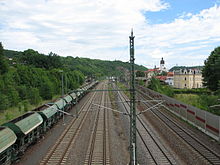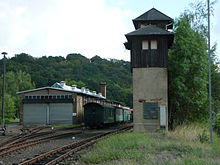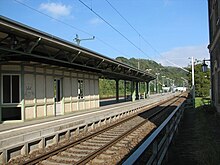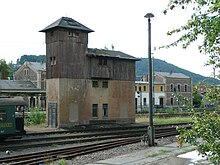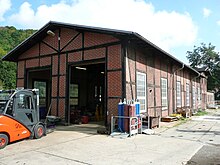Freital-Potschappel train station
| Freital-Potschappel | |
|---|---|
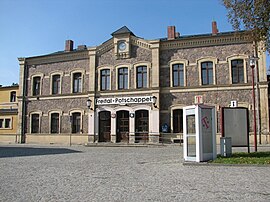 Entrance building, street side
|
|
| Data | |
| Operating point type | railway station |
| Location in the network | former connection station |
| Platform tracks | 2 |
| abbreviation | DPA |
| IBNR | 8013445 |
| opening | June 28, 1855 |
| Profile on Bahnhof.de | Freital-Potschappel |
| location | |
| City / municipality | Freital |
| Place / district | Potschappel |
| country | Saxony |
| Country | Germany |
| Coordinates | 51 ° 0 '48 " N , 13 ° 39' 43" E |
| Height ( SO ) | 161.83 m |
| Railway lines | |
|
|
| Railway stations and stops in Saxony | |
The Freital-Potschappel station (until 1921 only Potschappel station ) is an operating point on the Dresden – Werdau railway in the Freital district of Potschappel . From 1884 to 1972 the station was the starting point for the Freital-Potschappel-Nossen narrow-gauge railway . Today Freital-Potschappel serves in particular as an access point to the S3 line of the Dresden S-Bahn .
history
Potschappel station was opened with the inauguration of the double-track line operated by Albertsbahn AG (today's Dresden – Werdau line ). The Albertsbahn was created with the aim of being able to transport the hard coal extracted in the Döhlen Basin faster to Dresden. Potschappel was an important location for the Saxon hard coal industry, so opening a train station made sense. To develop the coal fields of the Royal Zauckerode coal works , the standard gauge Niederhermsdorf coal branch was opened a year later . It branched off at the Potschappel train station at the level of the porcelain factory , crossed under Roßthaler Strasse (today Carl-Thieme-Strasse ) and continued following the course of the Wiederitz to Niederhermsdorf . The opening of this line was on December 1, 1856.
From 1856 to 1875, over a million loads of 100 hundredweight coal were handled in Potschappel. This made the station one of the most important freight train stations in Saxony in the 1860s. At the same time, passenger traffic between Dresden and the up-and-coming industrial communities in the Döhlen basin also developed. In 1886 around 488,000 people were transported in 22 trains every day; In 1897, twice as many trains drove daily, with over a million passengers.
In 1886 the Potschappel – Wilsdruff narrow-gauge railway was opened and ensured more traffic. This stretch, which was extended to Nossen in 1889, was the first of the later Wilsdruffer network . The narrow-gauge railway used the track bed of the coal branch between Potschappel and Niederhermsdorf, only a third rail was inserted. The station had already been expanded at the end of the 1870s.
The resulting high traffic density on the railways burdened and also severely hindered the traffic at the level crossings. The situation worsened again with the commissioning of the tram line through Plauenschen Grund in 1902. A bottleneck formed at the Potschappel exit in the direction of Dresden, which could only be alleviated by raising the railway system from 1905 to 1909. As a result of the elevation, the reception building erected in 1855 was also converted. By 1914, the railway line was expanded to four tracks, and from then on, passenger and freight traffic could be handled separately at Potschappel station. During this time, the B1 signal box, which is still preserved today and is under monument protection , was built .
In the 1900s there were first considerations to introduce a narrow-gauge connecting track between Hainsberg and Potschappel. This should enable the exchange of locomotives between the Wilsdruffer narrow-gauge railway and the Weißeritztalbahn starting in Hainsberg . The possibility was also seen of having the Weißeritztalbahn begin in Potschappel via this connecting route in the future. After the expansion of the Dresden – Werdau railway line, a third rail could be inserted into an industrial siding, and the “ Potschappel-Hainsberger Connection Railway ” (PHV) was operational from September 1913. Since then, the Weisseritztalbahn wagons have been serviced in the wagon repair center on the Potschappler narrow-gauge platform. Until the 1960s and again in the 1990s, special trips on the Weißeritztalbahn were offered by the PHV from Potschappel.
With the formation of the city of Freital from the municipalities of Deuben , Döhlen and Potschappel, the Potschappler station was renamed "Freital-Potschappel" on June 1, 1921. On April 16, 1945, a bomb dropped on Dresden during the air raids hit the station facilities.
At the end of the 1950s, the VEB Steinkohlenwerk "Willi Agatz" completely stopped coal mining on the left of the Weißeritz; as a result, the railway lines leading to the dismantling sites were no longer profitable. In 1972 the branching narrow-gauge railway to Wilsdruff was shut down, only the standard-gauge section continued to be served for a few years with connecting traffic. Some of the tracks in the station area have been preserved to this day. Since the closure, the Potschappel station has been a pure through station again .
Since May 31, 1992 the Freital-Potschappel station has been served by the Dresden S-Bahn. The flood in August 2002 caused devastating damage to the railway systems, so that extensive repair and new construction measures had to be carried out in the following years. The platform and a bridge north of the train station were relocated a little to the southeast, the abutments of the old structure including the staircase to the platform at that time are still preserved. During the renovation work, large parts of the PHV line were also dismantled, so that a continuous narrow-gauge connection between Hainsberg and Potschappel no longer exists. The wagons of the Weißeritztalbahn and also those of the Lößnitzgrundbahn have since been transported by road to the Potschappel car repair center.
In 2019, the wagon repair station in the Freital-Hainsberg train station (connection to the Weißeritztalbahn) was completed, the overpasses on the road are no longer necessary.
At the same time, the station building was converted into a community center and opened in October 2019. There are now various offices (including the public order office, registry office) of the city of Freital. The citizens' office and tourist information are located on the ground floor. A multi-purpose area for district work and public events are available.
Railway systems
Railway systems standard gauge
The central platform is about 150 meters long. On the one hand, access is possible via a tunnel with a lift from the station building; on the other hand, there is a staircase at the bridge over Oberpesterwitzer Straße. In addition to the major renovation of the station with the elevation of the lines, freight traffic was separated from tourist traffic in the direction of Tharandt in the eastern part (1 km before reaching the station) , whereby the tracks from here are four-track. From the direction of Dresden the freight trains drove into the station on the right, the tracks on the left were intended for passenger traffic.
The reception building has a quarry stone facade and next to the main entrance two wings with extensions. A restaurant was housed in one of these extensions, and most of the building had not been used for a long time. Access to a tunnel and the platforms was possible via the entrance hall. The core of the station building dates from the time the route was opened and is a registered cultural monument . It was in private hands until 2014.
The city of Freital acquired the reception building in 2014 . As part of a renovation, around 40 administrative workplaces and new and contemporary parliamentary groups for the city council are to be created by 2019. Furthermore, a citizens' office and a multi-purpose area are planned on the ground floor, which will also be available for district work and public events.
The railway system has been controlled by an ESTW since 2003 . In this context, the two signal boxes B1 and W3 were inoperable and the signal box W3 was canceled in the same year.
Narrow gauge railway systems
The passenger platform on the line to Wilsdruff was located north of the standard gauge systems, both were connected by an underpass. The repair shop is right next to it. The tracks to Tharandt and Wilsdruff ran parallel for a few hundred meters before they parted at the porcelain factory. At the junction there was an old workers' house until the early 2000s, which was demolished in the course of the expansion of Carl-Thieme- / Roßthaler Straße. Between the ground floor and the narrow-gauge platform was an old baggage transfer system, which used to be used to move baggage back and forth between the routes. If you walk on the station tracks today, you might think it's lunch break in the company; the baggage transfer tower is still there, the tracks are still in place, and there are individual cars next to the car repair center (WAS). There has been no scheduled train here since 1972, and there were only transfers on the Potschappel-Hainsberger connecting railway until 2002 .
The narrow-gauge station consisted of an island platform , followed by two tracks to the north and the WAS further north, which was also accessible from the western side with two tracks. Further north, two narrow-gauge and two standard-gauge tracks led to the loading hall, and further north, two standard-gauge and four narrow-gauge tracks led to the loading lane with the head and side loading ramp. The trolley pit , however, was located south of the narrow-gauge platform. The five tracks south of the WAS were originally led via Pesterwitzer Strasse to the ground floor with bridges to the locomotive shed. Later the four northern bridges were removed and only one track led to the locomotive shed side. Photos from 1930 show that this condition already existed back then. In the early days of the railway, the narrow-gauge systems were rebuilt several times, the largest changes being made during the raising of the station's tracks in the years 1905–1909. The travelers got from the ground floor to the narrow-gauge platform through an underpass. For the luggage of the narrow-gauge railway, the imposing luggage transfer over the standard gauge tracks was built at that time, of which the tower is still present on the narrow-gauge side.
The locomotive shed was a half-timbered building in initially two-track and two-tier design. Originally it consisted of a storage and a repair stand. At the time of construction he owned a water station with a deep well, a water tank with a capacity of 13 m³ and a water crane . In 1905 the water system was connected to the public network in Freital. Two more locomotive stands and a slewing crane were added during later modernizations. The coaling system served together for narrow-gauge and standard-gauge tracks and could be used by the locomotives of the Windbergbahn . A field railway with 600 mm gauge, which was built into the standard gauge track, was used to coal the locomotives. From 1923 the locomotive shed was used as the locomotive station of the Nossen depot and from 1952 as the Wilsdruff depot . Today the engine shed is used by a private company and is in very good condition. All of the narrow-gauge railway tracks on the side of the locomotive shed have been removed and built over.
The former car repair facility in Freital Potschappel station is also still there. The direct track connection to Freital-Hainsberg train station via the Potschappel-Hainsberger connecting railway, which has existed since 1913, is probably the reason why so many narrow-gauge tracks are still available in Freital Potschappel train station. From 1996 to 2002 special train journeys were carried out here on a regular basis, with the former narrow- gauge platform of the Freital-Potschappel-Nossen narrow-gauge railway being reactivated for these journeys. The wagon repair hall was used for wagon repairs from the very beginning of the operation of the Freital-Potschappel-Nossen narrow-gauge railway. With the opening of the Potschappel-Hainsberger connecting railway, the car repair hall was also used to repair the wagons of the Weißeritztalbahn and Lößnitzgrundbahn . The WAS was expanded for the last time in the 1950s, and it was used for car repairs until the 1990s.
In addition, the narrow-gauge section of the station had a reloading hall, which still exists today, and a loading lane with a head and side loading ramp. Today, the narrow-gauge and standard-gauge tracks north of the reloading hall have been dismantled and Carl-Thieme-Strasse leads straight along here to Pesterwitzer Strasse. Even today there are still a lot of former objects from the narrow-gauge era, whose further use is worth thinking about.
Narrow gauge relics preserved in 2015
traffic
Standard gauge railway
In character, the station was a gauge changing station during the existence of the narrow-gauge railway , with a large number of passengers and goods being exchanged between the gauges. Otherwise the station only had the significance of a through station without a significant number of traffic stops. The train station used to be the most important of the Freital train stations on the main line , today it has lost this status to the Freital-Hainsberg train station . In the period before 1989, no information is available on the number of trains running through the station. There was about an hourly train service through the station, with freight traffic in the direction of Freiberg being quite considerable until 1989. Currently (2015) passenger trains run through the station every 30 minutes, whereby only the regional train (Dresden Hbf-Zwickau (Sachs) Hbf) and the S-Bahn line S3 (Dresden Hbf-Tharandt) stop at the station. Freight train traffic has decreased compared to earlier times.
Narrow gauge railway
The narrow-gauge railway Freital-Potschappel-Nossen was a highly frequented line compared to other narrow gauge railways. Construction projects along the route, such as the Niederwartha pumped storage plant or the Siebenlehn motorway bridge, resulted in high utilization of the narrow-gauge railway in freight traffic in addition to the local connections.
In passenger traffic, course book data have been available since 1894; At that time there was a daily traffic of four pairs of trains. In 1914 there were eleven pairs of trains. In 1925 there were again ten pairs of trains, in 1932 there were again eleven pairs of trains. In 1939 the traffic had grown to twelve pairs of trains. In the 1950/1951 timetable year there were still seven pairs of trains running on the small train, and in the last section of the timetable in 1971 six pairs of trains were still running to Wilsdruff, two of which only ran on weekdays.
environment
The train station is in the center of Potschappels, the entrance to the reception building is at the central “Platz des Handwerks”. The Potschappel Town Hall, today the administrative seat of the city of Freital, is only a few meters away. Other valuable buildings such as the Hofmühle, the Goldene Löwe or the former Central department store are in the vicinity. There is a connection to local public transport as well as private transport via the main traffic artery Dresdner Straße and the bus lines A and C of Stadtverkehr Freital . On the former narrow-gauge route, a side footpath has now been created that runs not far from the train station.
literature
- Kurt Kaiß, Matthias Hengst: Chemnitz railway junction - rail network of an industrial region. Alba, Düsseldorf 1996, ISBN 3-87094-231-2 .
- Ludger Kenning: Narrow-gauge railways around Mügeln and Wilsdruff . Kenning Verlag, Nordhorn 2000, ISBN 3-933613-29-9 .
Web links
- Potschappel - Hainsberg connecting railway , in it: pictures and texts relating to the Freital-Potschappel train station.
- Tracks in service facilities (DPA) , DB Netz AG (PDF)
- Freital-Potschappel train station on www.sachsenschiene.net
- Freital-Potschappel-Wilsdruff narrow-gauge railway on sachsenschiene.net
- Potschappel-Hainsberg connecting railway at www.sachsenschiene.net
Individual evidence
- ↑ Norbert Peschke : Transport node Volume 1 - Train stations in and around Zwickau. Foto & Verlag Jacobi, Fraureuth 2010, ISBN 978-3-937228-40-2 , p. 150 f.
- ^ Siegfried Huth: Freital in old views . tape 2 . Freital, ISBN 978-90-288-6314-9 .
- ↑ Juliane Puls: Freital. On the way to the city . Erfurt 2000, ISBN 3-89702-227-3 , p. 100 .
- ↑ Stadtverwaltung Freital (Hrsg.): Monuments in Freital - workshop report 3 of a municipal working group against forgetting . Freital 2013, p. 56 .
- ↑ Klaus Gottschling: History of the PHV line. In: lokomotive.de. Retrieved October 23, 2013 .
- ↑ Website about the Freital-Potschappel train station at www.sachsenschiene.net
- ^ Martin Wollmann: Wilsdruffer narrow gauge network: Freital-Potschappel - Wilsdruff. Retrieved October 23, 2013 .
- ↑ Track plan of the Freital-Potschappel train station on www.sachsenschiene.net
- ↑ a b Kurt Kaiß, Matthias Hengst: Chemnitz railway node - rail network of an industrial region. Alba, Düsseldorf 1996, ISBN 3-87094-231-2 , p. 147.
- ↑ Freital-Wilsdruff narrow-gauge railway timetable 1894 at www.sachsenschiene.net
- ↑ Freital-Wilsdruff narrow-gauge railway course book 1914 at www.sachsenschiene.net
- ↑ Freital-Wilsdruff narrow-gauge railway course book 1925 at www.sachsenschiene.net
- ↑ Freital-Wilsdruff narrow-gauge railway course book 1932 at www.sachsenschiene.net
- ↑ Freital-Wilsdruff narrow-gauge railway course book 1939 at www.sachsenschiene.net
- ↑ Freital-Wilsdruff narrow-gauge railway timetable 1950 on www.sachsenschiene.net
- ↑ Freital-Wilsdruff narrow-gauge railway timetable 1971 at www.sachsenschiene.net
